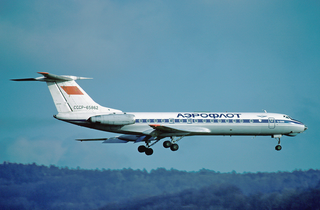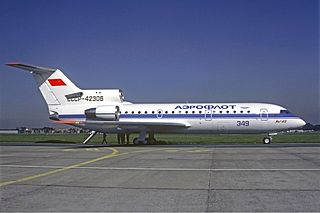
Wake turbulence is a disturbance in the atmosphere that forms behind an aircraft as it passes through the air. It includes various components, the most important of which are wingtip vortices and jetwash. Jetwash refers to the rapidly moving gases expelled from a jet engine; it is extremely turbulent, but of short duration. Wingtip vortices, however, are much more stable and can remain in the air for up to three minutes after the passage of an aircraft. It is therefore not true turbulence in the aerodynamic sense, as true turbulence would be chaotic. Instead, it refers to the similarity to atmospheric turbulence as experienced by an aircraft flying through this region of disturbed air.
JSC Uzbekistan Airways, operating as Uzbekistan Airways, is the flag carrier airline of Uzbekistan, headquartered in Tashkent. From its hub at Islam Karimov Tashkent International Airport, the airline serves a number of domestic destinations; the company also flies international services to Asia, Europe and North America.
Kazakhstan Airlines was an airline from Kazakhstan, serving as national flag carrier of the country from its independence in 1991 until 1996, when this role was transferred to Air Kazakhstan following the disaster of Flight 1907.

Ust-Kut Airport is an airport in Irkutsk Oblast, Russia which is located 9 km north of Ust-Kut. It services short-haul routes and links the town to Irkutsk and Krasnoyarsk.
Aviaarktika was a Soviet airline which started operations on 1 September 1930 and was absorbed by Aeroflot on 3 January 1960.

On 11 August 1979, a mid-air collision occurred over the Ukrainian SSR, near the city of Dniprodzerzhynsk. The aircraft involved were both Tupolev Tu-134As on scheduled domestic passenger flights, operated by Aeroflot.

Aeroflot, the Soviet Union's national carrier, experienced a number of serious accidents and incidents during the 1970s. The airline's worst accident during the decade took place in August 1979, when two Tupolev Tu-134s were involved in a mid-air collision over the Ukrainian city then named Dniprodzerzhinsk, with the loss of 178 lives. Including this event, there were nine deadly incidents with more than 100 fatalities, while the total recorded number of casualties was 3,541 for the decade.

Following is a list of accidents and incidents experienced by Aeroflot during the 1980s. The deadliest accident the carrier experienced in this decade occurred in July 1985, when Flight 7425, a Tupolev Tu-154B-2, stalled en route and crashed near Uchkuduk, then located in the Uzbek SSR, claiming the lives of all 200 occupants aboard the aircraft. The second deadliest accident the company went through in the decade took place in October 1984, when Flight 3352, a Tupolev Tu-154B-1, hit snowploughs upon landing at Omsk Airport, killing 174 of 179 people on board plus four people on the ground. Both accidents combined left a death toll of 378 casualties and involved a Tupolev Tu-154, ranking as the worst ones involving the type, as of February 2012.

After the dissolution of the Soviet Union in December 1991, its former republics started establishing their own carriers from the corresponding directorates Aeroflot had at these countries, causing the airline to shrink drastically. The fleet reduced from several thousand aircraft to a number slightly over 100 in 1993, helping the former Soviet Union's national airline to improve its accidents and incidents record sharply. The company experienced 42 events between 1990 and 1991 only, and had 41 occurrences in the rest of the decade. Despite this, the three deadliest accidents the airline went through in the decade occurred in the post-Soviet era, leaving a death toll of 257, each one involving more than 50 fatalities.

Aeroflot Flight 6551 was a scheduled domestic passenger flight on an Ilyushin Il-18B from Baku to Novosibirsk with a stopover in Tashkent that crashed on 11 May 1973 over Semipalatinsk in the Kazakh SSR, killing all 63 people aboard.

Aeroflot Flight 8641 was a Yakovlev Yak-42 airliner on a domestic scheduled passenger flight from Leningrad to Kyiv. On 28 June 1982, the flight crashed south of Mozyr, Belorussian SSR, killing all 132 people on board. The accident was both the first and deadliest crash of a Yakovlev Yak-42, and remains the deadliest aviation accident in Belarus.

Aeroflot Flight 528 was a regular commercial flight from Odessa to Berdyansk that crashed while attempting to land in poor weather conditions.

Aeroflot Flight 5003 was a scheduled passenger flight from Tashkent to Mineralnye Vody with a stopover in Nukus; the Ilyushin 18V operating the route on 15 February 1977 crashed near the district of Mineralnye Vody while climbing after a missed approach. Of the 98 people on board, 77 perished in the crash.

Aeroflot Flight 343 was a passenger flight from Moscow-Sheremetyevo Airport to Jorge Chávez International Airport, on a stopover at Luxembourg-Findel International Airport, that veered off the runway on 29 September 1982, fatally injuring seven occupants. The Ilyushin Il-62M operating the flight suffered a mechanical failure.

Aeroflot Flight 1080 was a Soviet domestic passenger flight from Yekaterinburg, Russia, to Kostanay, Kazakhstan, that crashed at night shortly after takeoff on 7 October 1978. All 38 passengers and crew were killed in the crash which occurred when one of the engines failed due to icing during initial climb out. At the time, the crash was the second worst in the history of the Yakovlev Yak-40, which had entered operational service with Aeroflot just ten years prior.

Aeroflot Flight U-45 was a passenger flight operated by an Ilyushin Il-18 that crashed during the approach to Samarkand on Friday, 6 February 1970, resulting in the death of 92 of the 106 people on board. An investigation revealed the aircraft went below the minimum obstacle clearance altitude (MOCA) during approach to Samarkand International Airport.

Aeroflot Flight 2 was a regularly scheduled passenger flight operated by Aeroflot from Vitim Airport in the Sakha Republic to Irkutsk International Airport near Irkutsk. On 20 July 1977, the Avia 14 operating this flight crashed into trees outside the airport shortly after takeoff. Thirty-three passengers and all six crewmembers were killed, while one passenger survived.

Aeroflot Flight 120 was an international Soviet passenger flight from Kabul International Airport in Afghanistan to Tashkent International Airport in the Uzbek SSR. On 13 December 1959 the Aeroflot Ilyushin Il-14P operating the flight crashed in the Boysun District killing all 25 passengers and 5 crew on board.
















